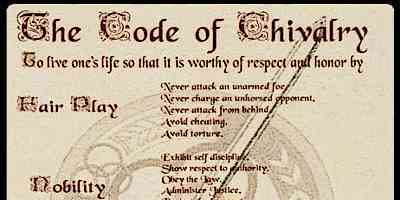

Thou shalt be generous, and give largess to everyone. Thou shalt never lie, and shall remain faithful to thy pledged word. Thou shalt perform scrupulously thy feudal duties, if they be not contrary to the laws of God. Thou shalt make war against the Infidel without cessation, and without mercy. Thou shalt not recoil before thine enemy.


Thou shalt love the country in the which thou wast born. Thou shalt repect all weaknesses, and shalt constitute thyself the defender of them.
#FRANCHISE CHIVALRY CODE CODE#
The Code of Chivalry (10 Commandments) Thou shalt believe all that the Church teaches, and shalt observe all its directions. Both sought sanctification of their members through combat against “infidels” and protection of religious pilgrims, and both had commitments that involved the taking of vows and submitting to a regulation of activities. The first orders of Chivalry were very similar to the monastic orders of the era. Europe aggressively sought to expand its area of control. Medieval Chivalry Chivalric orders first started with military activities against non-Christian lands. He loved the land of his birth and gave generously to all. He defended the church and was ready to die for it. Their poems show that a true knight had faith and a deep love of the Christian religion. The Code of Chivalry grew with the songs of the minstrels in the 1000’s and 1100’s. What Is Chivalry? Chivalry was the knight’s code of behavior. That the horse should be featured so prominently during the Age of Chivalry is etymologically appropriate, because chivalry goes back to the Latin word caballus, 'horse, especially a riding horse or packhorse.' Borrowed from French, as were so many other important words having to do with medieval English culture, the English word chivalry is first recorded in works composed around the beginning of the 14th century and is found in several senses, including 'a body of armored mounted warriors serving a lord' and 'knighthood as a ceremonially conferred rank in the social system.' Our modern sense, 'the medieval system of knighthood,' could not exist until the passage of several centuries had allowed the perspective for such a conceptualization, with this sense being recorded first in 1765. Bedecked in elaborate armor and other trappings, horses were certainly well dressed, although they might have wished for lighter loads. Word History (Cont.) The Age of Chivalry was also the age of the horse. 3) a group of knights or gallant gentleman B) a manifestation of any of these qualities. 2) A) the qualities idealized by knighthood, such as bravery, courtesy, honor, and gallantry toward women. Nicastroĭefine “Chivalry” and Word History 1) the medieval system, principles, and customs of knighthood. Code of Chivalry By Selena Thibodeau Period 3, Honors English Mrs.


 0 kommentar(er)
0 kommentar(er)
